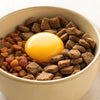What is Raw Dog Food Made Of? A Comprehensive Guide for Pet Owners
- Houndsy
Table of Contents
- Introduction
- Understanding Raw Dog Food
- Components of Raw Dog Food
- Benefits of Feeding Raw Dog Food
- Potential Risks of Raw Dog Food
- Making the Switch to Raw Dog Food
- Conclusion
Introduction
Have you ever wondered why your dog seems more interested in your dinner than his kibble? As dog owners, we want what’s best for our furry companions, and the growing interest in raw dog food diets prompts a pivotal question: What is raw dog food made of? Raw dog food, often touted for its potential health benefits, claims to offer a more natural alternative to traditional commercial pet foods. It’s a burgeoning trend that piques our curiosity and concern alike as we navigate our pet care choices.
In this blog post, we will delve deeply into the world of raw dog food, exploring its components, benefits, potential risks, and best practices for transition. By the end, you'll have a comprehensive understanding of what constitutes raw dog food and how it might improve your pet's overall well-being.
Join us on this informative journey as we actively consider the implications for our dog's nutrition and health. Are you ready to reflect on your current feeding choices and perhaps even explore a new approach that could invigorate your dog's life?
Understanding Raw Dog Food
What is Raw Dog Food?
At its core, raw dog food is made from unprocessed food sources that deliver essential nutrients to dogs in their natural state. This diet primarily consists of:
- Muscle meat: Cuts such as chicken, beef, or lamb.
- Organ meat: Nutrient-rich options like liver and kidney.
- Raw meaty bones: Provide not just nutrition but also dental benefits.
- Vegetables and fruits: Often included in small quantities to offer additional vitamins and minerals.
- Supplements: Such as omega fatty acids and probiotics, to boost nutritional balance.
In essence, raw dog food aims to recreate the ancestral diet of dogs—what they would have consumed in the wild before the advent of processed foods. This means ensuring a high proportion of meat and nutritional variety aimed at mimicking a balanced, natural diet.
The Evolution of Dog Diets
Historically, dogs were scavengers and predators, finding their food in the wild. This behavior is at the heart of the concept of a raw dog food diet. With the development of commercial pet food in the mid-20th century, the nutritional needs of dogs became a topic of debate. The movement towards raw feeding is partly a response to perceived deficiencies in processed foods and the desire to offer our pets a diet that aligns with their physiological needs.
As pet owners, we at Houndsy recognize the importance of understanding where our pets' food comes from. Our commitment to enhancing the dog-feeding experience reflects the desire for healthy, convenient, and aesthetically pleasing solutions, leading us to explore the principles and offerings of raw diets.
Components of Raw Dog Food
Protein Sources
1. Muscle Meat: This category makes up the bulk of a raw diet. Common sources include beef, chicken, turkey, and lamb. These protein sources provide essential amino acids critical for muscle function, energy, and overall health.
2. Organ Meat: Often referred to as offal, organ meats such as liver, heart, and kidney are nutrient powerhouses. They offer essential vitamins like A, D, E, and K, along with minerals like iron and zinc, vital for a balanced diet.
3. Raw Meaty Bones: Bones, ground or whole, supply not only essential calcium and phosphorus but also serve as natural dental chews that help keep teeth clean and strong. When choosing bones for a raw diet, it's crucial to opt for non-weight-bearing bones to prevent splintering.
Plant-Based Ingredients
4. Vegetables and Fruits: While dogs are primarily carnivorous, incorporating small amounts of vegetables and fruits can increase the variety of nutrients in their diet. Ingredients like carrots, spinach, blueberries, and apples not only provide fiber but also beneficial vitamins.
Nutritional Supplements
5. Omega Fatty Acids: Essential fatty acids, particularly Omega-3 and Omega-6, are often added to support skin health, improve coat shine, and reduce inflammation.
6. Probiotics and Prebiotics: These ingredients foster gut health, helping to maintain a healthy digestive system, which is pivotal in nutrient absorption.
Benefits of Feeding Raw Dog Food
Many proponents of raw dog food diets tout various health benefits. Some of the most commonly reported advantages include:
Improved Digestion and Health
The first noticeable change many pet owners report when transitioning their dogs to a raw diet is improvements in stool quality. Raw-fed dogs often produce firmer, smaller stools that are easier to clean up—a reflection of better digestion and nutrient absorption.
Healthier Skin and Coat
A raw dog food diet can result in shinier fur and healthier skin due to the high-quality fat content present in raw meats and added supplements. The balanced fatty acids contribute to maintaining a healthy skin barrier, reducing dryness and inflammation.
Enhanced Energy Levels
Many dogs exhibit increased energy levels and playful behavior once they switch to raw diets, which could be attributed to a more nutritious and easier to digest food source.
Dental Health
Chewing on raw meaty bones can get rid of plaque and tartar buildup, promoting better dental health. This can mitigate dental diseases, which are common in many pets.
These benefits highlight the compelling reasons some dog owners might consider exploring raw diets. However, while the positives are enticing, caution should also be exercised in ensuring a balanced diet and avoiding common pitfalls associated with raw feeding.
Potential Risks of Raw Dog Food
Bacterial Contamination
One of the primary concerns surrounding raw dog food is the potential for harmful bacteria such as Salmonella and E. coli. These pathogens can pose risks not only to pets but also to humans handling the raw food. While proponents argue that good hygiene in preparing and handling raw food can mitigate these risks, it remains a crucial consideration for pet owners.
Nutritional Imbalances
Creating a balanced raw diet at home can be tricky. If not formulated correctly, it may lead to nutritional deficiencies or excesses. For instance, a diet lacking in calcium may result in bone issues. Therefore, it’s essential to either refer to reputable raw feeding guides or consult with pet nutrition experts to ensure the diet is well-rounded.
Cost and Convenience
Feeding raw can also be more expensive than conventional dog food, not to mention the time it takes to prepare balanced raw meals. For busy pet owners, the natural appeal of raw diets might clash with their lifestyle needs.
Making the Switch to Raw Dog Food
Transitioning your dog to a raw diet requires careful planning and gradual implementation. Here are some steps to consider:
Step 1: Research and Plan
Educate yourself about raw feeding and gather recipes or consult with a vet or pet nutritionist experienced in raw diets. Understanding the nutritional needs based on your dog’s size, age, and activity level will be vital.
Step 2: Gradual Introduction
Begin by mixing raw food with your dog’s regular kibble in increasing quantities over several days or weeks. This gradual transition helps prevent digestive upset.
Step 3: Monitor Your Dog
Watch for signs of improvement or adverse reactions in your dog’s digestion, energy levels, and overall health throughout the transition.
Step 4: Adjust as Needed
Be prepared to make adjustments if you notice your dog’s health does not improve or if they experience digestive disturbances.
Step 5: Consult Professionals
Don't hesitate to reach out to a professional for guidance during the transition. Many dedicated raw feeding communities and advisors can provide tailored advice based on your pet's specific needs.
Integrate the Houndsy Kibble Dispenser: Convenience Meets Functionality
At Houndsy, we recognize that every aspect of pet care should be simple, convenient, and aesthetically pleasing. Our Houndsy Kibble Dispenser (Order Now: Houndsy Kibble Dispenser) is designed to streamline your dog's feeding routine while complementing your home decor. It features perfect portion control, a large 25–30 lb capacity, and is constructed from high-quality, BPA-free materials. By enhancing your feeding experience, it ensures your pet gets the nutrition they deserve without the mess and hassle.
Conclusion
Understanding "what is raw dog food made of" allows pet owners to make informed decisions about their furry friends' diets. Though raw diets have their advantages, it's crucial to be aware of the potential risks and to implement these changes thoughtfully.
By considering transitioning to raw or incorporating elements into your dog's diet, you can take proactive steps in improving their health and well-being.
Reflect on your current feeding practices and explore how a raw diet may positively impact your beloved companion. If you've found this information helpful, now’s a great time to think about how the Houndsy Kibble Dispenser can support you in delivering the best feeding experience for your dog.
FAQ
1. Can all dogs eat raw food? Not all dogs can thrive on a raw diet. Puppies, older dogs, or pets with certain health conditions may require special dietary considerations. Consulting a veterinarian is always recommended before making significant changes.
2. How can I ensure my raw dog food diet is balanced? Consult with a pet nutrition expert or refer to reputable raw feeding guides. The diet should include a variety of meats, organ meats, bones, vegetables, and essential supplements to provide balanced nutrition.
3. How often should I feed my dog raw food? The frequency can vary by age, weight, and activity level. A general guideline is to feed adult dogs 2-3% of their body weight daily, with some preferences for portions throughout the day.
4. What are the risks of raw dog food diets? Potential risks include bacterial contamination, nutritional imbalances, and higher costs. It’s essential to maintain high hygiene standards and consult professionals for balanced recipes.
5. What is the difference between BARF and Prey Model diets? The BARF (Biologically Appropriate Raw Food) diet focuses on a combination of raw meat, bones, vegetables, and fruits, while the Prey Model diet replicates the proportions of nutrients found in a prey animal, emphasizing primarily meat and bones.
By investing time and thought into what our dogs eat, we elevate their health and happiness. Let’s strive to provide them not just with food but with the right kind of nutrition they naturally thrive on.












